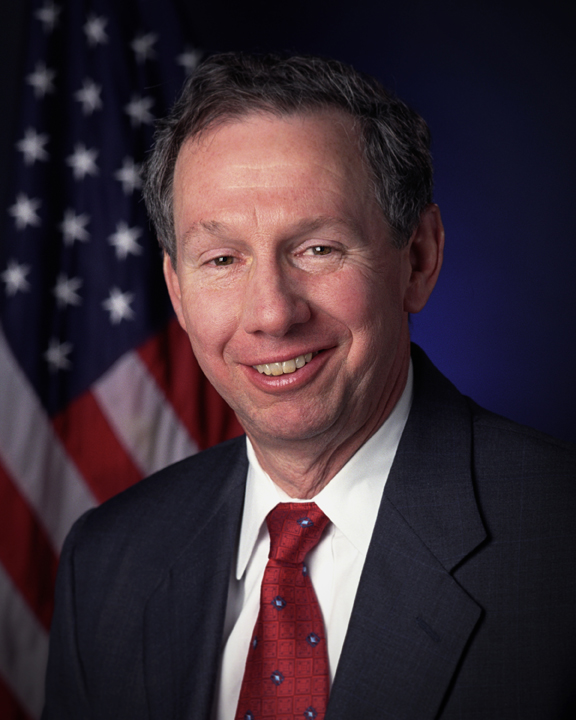2009 NATIONAL SPACE TROPHY RECIPIENT
Dr. Michael D. Griffin

Michael Douglas Griffin
Michael Griffin served as the 11th administrator of the National Aeronautics and Space Administration (NASA) from April 2005 to January 2009. As administrator, he led the NASA team and managed the United States' Space Exploration Policy.
Griffin was born in 1949 in Aberdeen, Maryland. He graduated as salutatorian of Aberdeen High School in 1967. He obtained his BA in physics in 1971 from the Johns Hopkins University, which he attended as the winner of a Maryland Senatorial Scholarship. His first job was with Singer Corporation in 1972 where he worked on aircraft weapons trainers.
He started his career in space in 1974 at NASA Goddard Spaceflight Center in Maryland where he worked for Computer Science Corporation (CSC) on the Atmospheric Explorer-C. While there he earned a master's degree in aerospace science from Catholic University. He left CSC to attend graduate school full time. He was awarded his PhD in aerospace engineering from the University of Maryland in 1977. He then moved to California to work at the Jet Propulsion Laboratory (JPL) on Mars rover and sample return programs until late 1979. He also earned another master's degree, in electrical engineering, from the University of Southern California in 1979.
From JPL, Griffin went to Johns Hopkins University where he earned another master's degree, this one in applied physics in 1983, and then taught graduate-level applied mathematics from 1984 to 1985. He joined the staff as a project engineer on several SDIO and U.S. Air Force projects as well as the Hubble Space Telescope. From 1980 to 1986, he also taught aerospace engineering at the University of Maryland.
He left John Hopkins to join the American Rocket Company in California in 1986 and worked on commercial low-cost launch vehicle development. He moved east again in late 1987 to work for the Department of Defense SDIO. Continuing his academic interests, in 1990, he earned a master's in business administration from Loyola College of Maryland, and spent five years teaching aerospace engineering at George Washington University in DC. He wrote dozens of technical papers and co-authored, with James French, the textbook, Space Vehicle Design, which was published by the American Institute of Aeronautics and Astronautics (AIAA) in 1991 and in a second edition in 2004.
Griffin became NASA associate administrator for Exploration from September 1991 to February 1993. He was co-director of the Access to Space Study in 1992, team leader for the 1993 space station redesign, and led NASA efforts to analyze the Mars Observer failure. In 1993, Griffin was named NASA's chief engineer, responsible for review of all NASA programs.
Griffin served as general manager of Space Industries in Houston from early 1994 to mid 1995. He then joined Orbital Sciences in Virginia as Space Systems Group manager, where he was responsible for all space systems development programs including the X-34 reusable launch vehicle and the ORBCOMM and ORBVIEW satellite constellations. In 1998, he earned his sixth advanced degree, a master's in civil engineering from George Washington University. That year, he became chief operating officer of Magellan Systems, Inc., a division of Orbital Sciences, when the previous CEO unexpectedly resigned. He restructured the team, found a buyer for the company, and led the transition to the new owner.
From August 2002 to March 2004, Griffin was president and chief operating officer of In-Q-Tel and worked on advanced technologies for CIA applications. He then returned to Johns Hopkins University as Space Department head. He initiated ISO9001 quality management certification efforts and oversaw the preparation, launch, and early operations of the MESSENGER spacecraft that launched to Mercury in August 2004. He was with John Hopkins when he was selected to become NASA Administrator by President Bush in 2005. His time at NASA ended with the transition to the Obama Administration in January 2009.
Griffin is a Registered Professional Engineer in Maryland and California, a member of the National Academy of Engineering and the International Academy of Astronautics, an honorary fellow of the American Institute of Aeronautics and Astronautics (2006), a fellow of the American Astronautical Society (2002), and a senior member of the Institute of Electrical and Electronic Engineers.
A commercial pilot and certified flight Instructor with instrument and multi-engine ratings, besides flying, Griffin enjoys golf, amateur radio (he holds an extra class amateur radio license), skiing, and scuba diving.
Griffin is the recipient of numerous honors and Stellar Awards, including the Defense Department's highest award which can be conferred on a non-government employee, Distinguished Public Service Medal (1986); the AIAA Space Systems Medal (1988), the Significant Technical Accomplishment Award (Delta 183 Mission Team) from the American Defense Preparedness Association (1989); the NASA Exceptional Achievement Medal (1994); the Goddard Astronautics Award (2007); and selection by Time Magazine as one of the 100 Most Influential People of 2008. Griffin received the Rotary National Award for Space Achievement's National Space Trophy in May 2009.
Biographical data current as of February 27, 2009
Please direct questions and reprint requests to Marianne Dyson.
Mike Griffin Receives 2009 National Space Trophy Post Event Press Release. Read text including excerpts from his speech on the 2009 Press page. A Transcript of Griffin's Speech is available as a Word doc file. Read a more in-depth profile of Griffin from the 2009 program book.
Read press release on the 2009 Press page, as a Word document, or as a pdf. Here is a Word document of Griffin's Biography separately from the press release.
